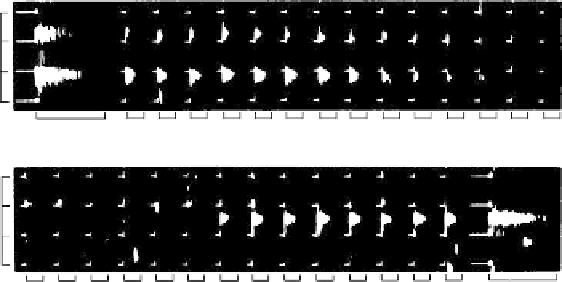Geoscience Reference
In-Depth Information
Jicamarca
18 February 1971
2031
2032
2034
2036
2038
2040
2042
2044
113
93
2046
2048
2050
2052
2054
2056
2058
2100
113
93
0 20
Relative echo power (dB)
Figure 4.23
Example of the change in altitude of the scattering regions before and after
the electrojet reversal, which occurred at about 2048-2050. [After Fejer et al. (1975).
Reproduced with permission of the American Geophysical Union.]
113 km. The daytime power profile as a function of height shows a single peak that
remains at a constant altitude (about 103 km). The nighttime scattering is much more
structured. Plume-like rising structures in the altitude region of 115 to 125 km with
upward Doppler velocities were also observed during nighttime from off-equatorial
regions (Patra and Rao, 1999).
4.
Wavelength dependence
: The vast majority of data concerning the electrojet is,
of course, at 3m wavelength. Interferometric techniques have been introduced at
Jicamarca, which show that the scattering cells are often organized into kilometer-
scale wave structures that propagate horizontally at about one-half the acoustic speed.
An example is shown in Fig. 4.25. The most intense backscatter (darkest regions) is
related to vertical 3m waves traveling at the acoustic speed. It seems clear that the
large-scale wave is organizing and creating the conditions that produce the vertically
propagating acoustic waves. Notice that one wave period requires about 60 s to pass
over Jicamarca in this example.
Occasionally during magnetic activity or special tidal conditions, the daytime
electrojet current reverses sign, a counter electrojet. Radar observations in such
conditions find that two-stream waves obey the relationship
V
ph
θ
(Hanuise and Crochet, 1981; Woodman and Chau, 2002). During such con-
ditions the relative directions of the vertical gradient and the electric field are
stable. This means that there is no situation for which both two-stream and
gradient drift are unstable and large-scale waves do not occur. These results are
in agreement with auroral zone data (Bahcivan et al., 2005; see Chapter 10) and
a new interpretation of type 1 radar scattering properties as a function of angle
(see Section 4.8.2).
=
C
s
cos

Search WWH ::

Custom Search